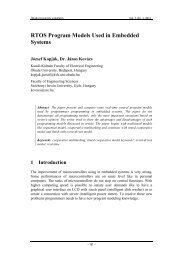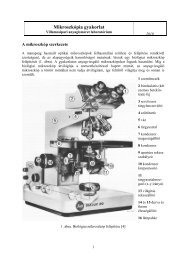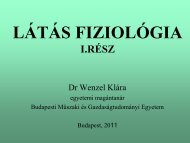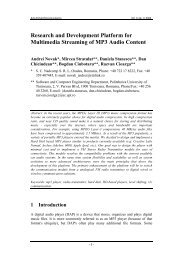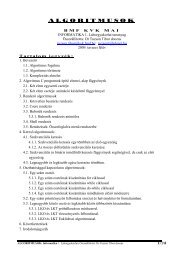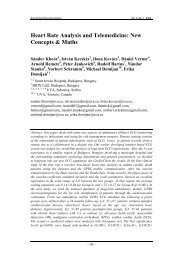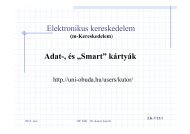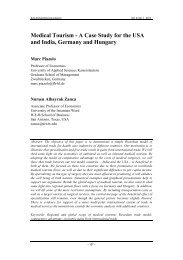You also want an ePaper? Increase the reach of your titles
YUMPU automatically turns print PDFs into web optimized ePapers that Google loves.
Francis Edel<strong>in</strong>e <strong>The</strong> use <strong>of</strong> colour <strong>in</strong> visual poetry<br />
and to look at them as black surfaces on a white background: as shadows. Beyond<br />
the shock produced by this unusual <strong>in</strong>junction, a more subtle metaphor can be<br />
perceived : the words as signifiers are dist<strong>in</strong>ct from their signifieds, just as the<br />
image <strong>of</strong> an object is dist<strong>in</strong>ct from the object itself (cf. the well-known pa<strong>in</strong>t<strong>in</strong>g by<br />
Magritte This is not a pipe). We are rem<strong>in</strong>ded that <strong>in</strong> poetry we are not <strong>in</strong> the real<br />
world, we are us<strong>in</strong>g codes made <strong>of</strong> symbols, and symbols are, only and<br />
<strong>in</strong>escapably, <strong>in</strong>direct and remote ways <strong>of</strong> look<strong>in</strong>g at th<strong>in</strong>gs.<br />
In experimental psychology there is a well-known teaser show<strong>in</strong>g the names <strong>of</strong><br />
several colours pr<strong>in</strong>ted <strong>in</strong> a colour different from the one they are nam<strong>in</strong>g (Fig.1).<br />
One discovers that it is extremely difficult to tell rapidly <strong>in</strong> which colour each <strong>of</strong><br />
these words is pr<strong>in</strong>ted. This effect can only be neutralized if all the words are<br />
pr<strong>in</strong>ted <strong>in</strong> the same colour (preferably black but this is only a matter <strong>of</strong> cultural<br />
convention). When we are switched on the l<strong>in</strong>guistic code, it blocks (or<br />
considerably <strong>in</strong>hibits) the perception <strong>of</strong> images as such. <strong>The</strong> reverse is also true:<br />
the two codes are strongly <strong>in</strong>teract<strong>in</strong>g and tend to be mutually exclusive.<br />
<strong>Colour</strong>, as everyone knows, is a dimension <strong>of</strong> the visual sign, together with form<br />
and texture. <strong>Visual</strong> signs, on the other hand, are one <strong>of</strong> the two ma<strong>in</strong> media used<br />
for the transmission <strong>of</strong> language (the use <strong>of</strong> touch, while possible, rema<strong>in</strong>s <strong>in</strong><br />
practice restricted to the bl<strong>in</strong>d).<br />
In the middle <strong>of</strong> the twentieth Century, there appeared throughout the world a<br />
number <strong>of</strong> poets will<strong>in</strong>g to exploit more fully the other dimensions <strong>of</strong> the visual<br />
sign, namely form and colour. Of course form was already readily usable, even <strong>in</strong><br />
black pr<strong>in</strong>t. And there were many forerunners, <strong>in</strong>clud<strong>in</strong>g <strong>in</strong> the Greek antiquity,<br />
where rhopalic verses were <strong>in</strong> favour. In modern times however, shaped poems or<br />
calligrams have known a tremendous development.<br />
<strong>Colour</strong> has also been used <strong>in</strong> the past, but to a small extent and to very little<br />
import. One is hardly able to mention more than the use <strong>of</strong> red characters by<br />
Hraban MAUR (Fig.2) and a few other <strong>in</strong>stances. For these authors colour was<br />
only a way to underl<strong>in</strong>e or emphasize part <strong>of</strong> the content. This does not imply that<br />
poets and writers were not responsive to colour. One memorable <strong>in</strong>stance is the<br />
abundantly quoted l<strong>in</strong>es by Andrew MARVELL (<strong>The</strong> Garden, end <strong>of</strong> 6 th stanza):<br />
Annihilat<strong>in</strong>g all that’s made<br />
To a green thought <strong>in</strong> a green shade.<br />
Poets wrote about colour but did rarely use colour. <strong>The</strong> possibilities <strong>of</strong> modern<br />
pr<strong>in</strong>t<strong>in</strong>g totally changed the situation, and visual poets,- as they came to be called,-<br />
took the full measure <strong>of</strong> these new means, and were able to employ colour as an<br />
<strong>in</strong>tegral means <strong>of</strong> signification <strong>in</strong>stead <strong>of</strong> a mere ornament.<br />
– 286 –




